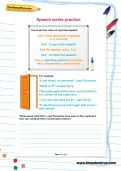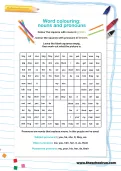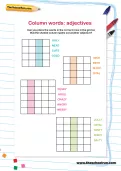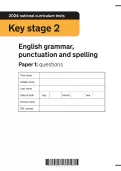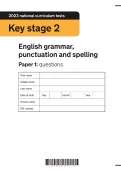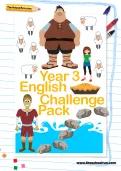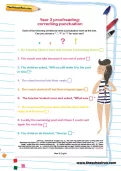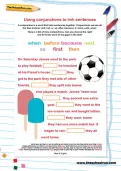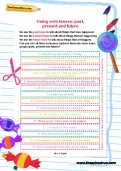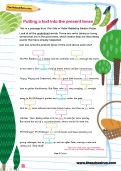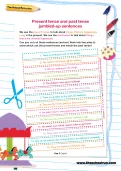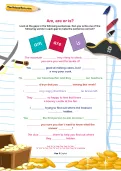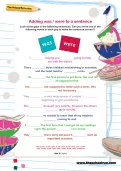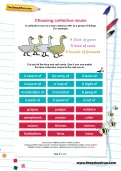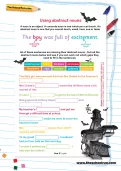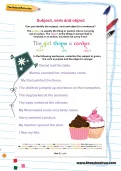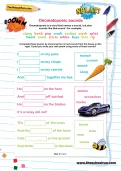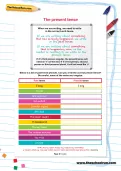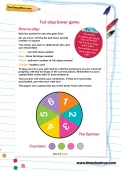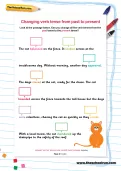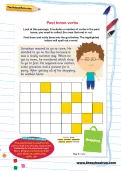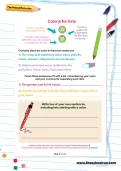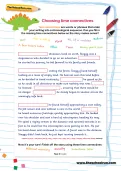Year 3 Grammar worksheets
Free worksheets: Grammar, KS2, Y3
You’ll need to login or Register first to access these worksheets for free.
Once you’ve tried out our free worksheets, why not explore all our resources (1000s of worksheets, interactive tutorials, learning packs and more) with a 14-day FREE trial subscription.
Speech marks practice
A KS2 literacy worksheet created by a primary-school teacher to help Year 3 children practise using speech marks correctly.
Can you continue this conversation between Harry and Thenusha using the correct rules for reported speech? Remember to start each character’s speech on a new line. Use “ to open the speech. End the speech with !, ? or , and use ” to close the speech. Use a reporting clause (a verb like said, whispered or announced).
Can you continue this conversation between Harry and Thenusha using the correct rules for reported speech? Remember to start each character’s speech on a new line. Use “ to open the speech. End the speech with !, ? or , and use ” to close the speech. Use a reporting clause (a verb like said, whispered or announced).
Word colouring: nouns and pronouns
Colour the squares with nouns in green. Colour the squares with pronouns in brown. Leave the blank squares empty, then work out what the picture is.
Column words: adjectives
Can you place the words in the correct rows in the grid so that the shaded column spells out another adjective?
Key Stage 2 - 2024 English SATs Papers
Help your child prepare for the Year 6 English SATs, taken at the end of Key Stage 2, with some revision and at-home practice. These KS2 SATs past papers from 2024 are the official past papers from the Department for Education, used in schools.
Key Stage 2 - 2023 English SATs Papers
Help your child prepare for the Year 6 English SATs, taken at the end of Key Stage 2, with some revision and at-home practice. These KS2 SATs past papers from 2023 are the official past papers from the Department for Education, used in schools.
Year 3 English Challenge Pack
Challenging reading comprehensions and activities for Year 3 readers and writers, designed to stretch your child and offer them the opportunity to explore their year-group topics in greater depth.
Year 3 proofreading: correcting punctuation
Each of the following sentences need a punctuation mark at the end. Can you choose a “.”, “?” or “!” for each one?
Using conjunctions to link sentences
A conjunction is a word that links sentences together. Conjunctions we use all the time include: and, but, or, so, after, because, if, since, until, when. Here is a list of time conjunctions. Can you choose the right one to fit into each of the gaps in the text?
Using verb tenses: past, present and future
Can you cut out these sentences and sort them into three tense groups (past, present and future)?
Putting a text into the present tense
This is a passage from The Tale of Peter Rabbit by Beatrix Potter. Look at all the underlined words. These are verbs (doing or being words) that are in the past tense, which means they are describing events that have already happened. Can you write the present tense of the verb above each one?
Present tense and past tense jumbled-up sentences
We use the present tense to talk about things that are happening now, in the present. We use the past tense to talk about things that have already happened. Can you cut out these sentences and sort them into two piles to show which use the present tense and which the past tense?
Am, are or is?
Look at the gaps in the following sentences. Can you write one of the following words in each gap to make the sentence correct?
Adding was / were to a sentence
Look at the gaps in the following sentences. Can you write one of the following words in each gap to make the sentence correct?
Choosing collective nouns
A collective noun is a noun used to refer to a group of things. Cut out all the blue and red cards. See if you can match the blue collective nouns to the red nouns.
Using abstract nouns
A noun is an object. A concrete noun is one which you can touch. An abstract noun is one that you cannot touch, smell, hear, see or taste. All of these sentences are missing their abstract nouns. Cut out the
abstract nouns below and see if you can work out which gaps they need to fill in the sentences.
abstract nouns below and see if you can work out which gaps they need to fill in the sentences.
Subject, verb and object
In the following sentences, underline the subject in green, the verb in purple and the object in orange
Onomatopoeic sounds
Onomatopoeia is a word that names a sound, but also sounds like that sound. Complete these poems by choosing the correct words from the boxes on the right. Could you write your own poem using some of these words?
The present tense
Here is a list of past tense phrases. Can you write the correct present tense? Be careful, some of the verbs are irregular...
Changing verb tense from past to present
Look at this passage about a playful cat. Can you change all the verb tenses from the past tense to the present tense?
Past tense verbs
Look at this passage. It includes a number of verbs in the past tense; you need to collect the ones that end in -ed. Find them and write them into the grid below. The highlighted letters will spell out a word.
Colons for lists
Can you correctly place the colon in these two sentences then finish these sentences off with a list, remembering your colon and your commas for separating each item.
Choosing time connectives
Time connectives are words or phrases that order your writing into a chronological sequence. Can you fill in the missing time connectives below so the story makes sense?
